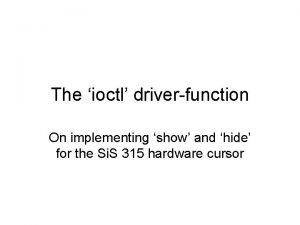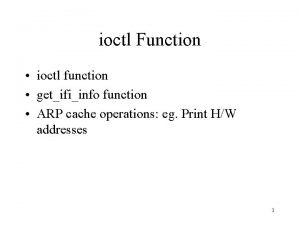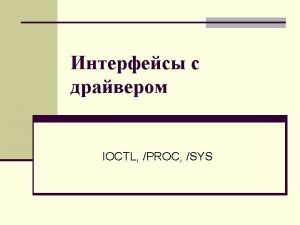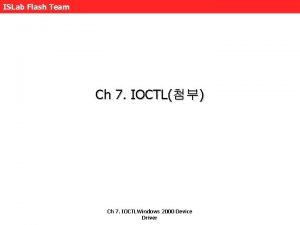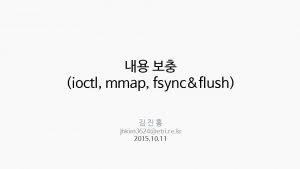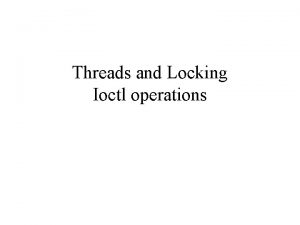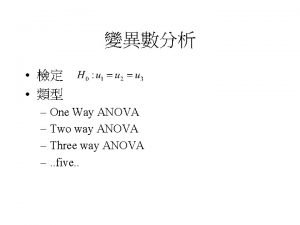The ioctl driverfunction On implementing a way to













- Slides: 13

The ‘ioctl’ driver-function On implementing a way to query and modify our UART’s baudrate via the ‘device-file’ abstraction

‘struct file_operations’ • For a Linux device-driver’s ‘module_init()’ function, there are two main actions: – Initializing the driver’s global data-structures (this includes verifying the device’s presence) – Registering the driver’s service-functions with the kernel (i. e. , the ‘file_operations’ structure) • The driver’s ‘module_exit()’ function then has the duty to ‘unregister’ those services

Driver services • For character-mode device-drivers (like ‘dram. c’, ‘cmos. c’ and ‘vram. c’), we have implemented some (or all) of the following service-functions (i. e. , driver ‘methods’): – – read() llseek() write() mmap()

The ‘file’ paradigm • The UNIX approach to device-control is to create objects that represent i/o-devices, but which behave like ‘files’ do, insofar as the application programmer is concerned • So ‘read()’, ‘lseek()’, ‘write()’ and ‘mmap() use the same function-call syntax – and in most respects the same semantics – for both ordinary ‘files’ and ‘device-files’

An imperfect paradigm • But often there a few ways in which the file-object paradigm doesn’t quite fit with important features of an i/o device • In these cases, device-drivers can provide a ‘workaround’ that allows applications to perform device-actions that deviate from customary ‘read/write/seek’ file-like actions • This ‘workaround’ mechanism is ‘ioctl()’

The serial UART • Our PC’s serial UART device offers us an easy example of some desirable behavior that’s outside the traditional ‘file’ paradigm • In order to use our ‘dev/vram’ device-file for communications with computers that we can’t control, we may need to adjust our UART’s communication parameters • How can a program change ‘baudrate’?

Our ‘baudrate. c’ module • These techniques are demonstrated in this device-driver module’s ‘ioctl()’ function • Two IOCTL services are implemented: #define GET_BAUDRATE 0 #define SET_BAUDRATE 1 • Applications can open the device-file and invoke an ‘ioctl’ system-call; for example: int fd = open( “/dev/uart”, O_RDWR ); ioctl( fd, GET_BAUDRATE, &baudrate );

Recall role of a device-driver A device-driver is a software module that controls a hardware device in response to OS kernel requests relayed, often, from an application operating parameters RAM device-driver module user application call ret standard “runtime” libraries user space hardware device in out call ret syscall Operating System kernel sysret kernel space

UART’s baudrate-control i/o port 0 x 03 F 8 LSB DIVISOR LATCH (bits 7. . 0) i/o port 0 x 03 F 9 MSB DIVISOR LATCH (bits 15. . 8) i/o port 0 x 03 FB 7 6 5 4 3 2 D L A B B R E A K parity controls stop bits 1 0 data bits LINE CONTROL REGISTER

Algorithm to ‘get’ baudrate • • • Input (and save) the LINE_CONTROL Set DLAB-bit in LINE_CONTROL to 1 Input (and save) the DIVISOR_LATCH Restore LINE_CONTROL to former value Compute ‘baudrate’ from divisor_latch: baudrate 115200 / divisor_latch • Return this current ‘baudrate’ value

Algorithm to ‘set’ baudrate • Receive ‘baudrate’ as function-argument • Verify that argument is within valid range • Compute ‘divisor_latch’ from ‘baudrate’: divisor_latch 115200 / baudrate • • Input (and save) the LINE_CONTROL Set DLAB-bit in LINE_CONTROL to 1 Output ‘divisor_latch’ to UART register Restore LINE_CONTROL to former value

Demo-program: ‘setbaud. cpp’ • This application-program lets a user query or modify the UART’s current baudrate in a convenient manner – without requiring any ‘special’ privileges (don’t need ‘iopl 3’) • To see the current baudrate: $. /setbaud • To change the current baudrate: $. /setbaud 2400

In-class exercise • Can you modify our ‘baudrate. c’ driver so it implements an additional ‘ioctl’ service: # define GET_LINECTRL 2 • Then add an extra ‘ioctl’ system-call in our ‘setbaud. cpp’ application so that it displays the UART’s current data-format (as well as baudrate) using format similar to 8 -N-1 • HINT: look at driver’s ‘get_info()’ function
 Conventional software
Conventional software One way table and two way table
One way table and two way table One-way anova hypothesis testing
One-way anova hypothesis testing When i was one i had just begun the day i went to sea
When i was one i had just begun the day i went to sea Perbedaan one way dan two way anova
Perbedaan one way dan two way anova One way anova vs two way anova
One way anova vs two way anova Talk this way
Talk this way What is a threaded binary tree traversal?
What is a threaded binary tree traversal? Two way anova
Two way anova Perbedaan two way anova dan one way anova
Perbedaan two way anova dan one way anova Implementing merchandise plans
Implementing merchandise plans Setting prices and implementing revenue management
Setting prices and implementing revenue management Matching structure with strategy
Matching structure with strategy Crm project design and planning process
Crm project design and planning process














